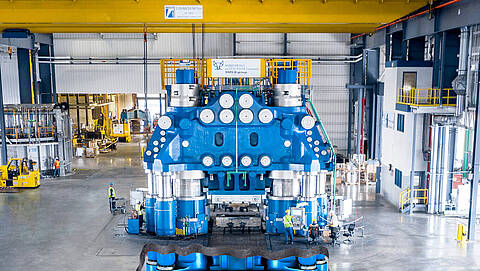
UL-certified switchgear construction For the world's most powerful hydraulic drop-forging press
Our client:
SMS group GmbH
SMS group is an internationally active group of companies involved in the supply of plant and machinery to the steel and non-ferrous metal industry. The group employs some 14,000 people and generates worldwide sales of more than 2.8 bn euros. The sole owner of the holding company SMS GmbH is the Family Weiss Foundation.
As a leading provider of custom-designed metallurgical plant and machinery, SMS group delivers new plant and upgrade projects ranging from plant engineering and end-to-end automation through to individual component replacement.
The commission
The American company Weber Metals, which is part of the OTTO FUCHS Group, commissioned SMS group to build a hydraulic pull-down die forging press of unprecedented proportions. The machine has a pressing power of 540 meganewtons, which is equivalent to 60,000 US short tons. This is why the complex piece of machinery, with its digital technology, is also named the '60k press'.
Weber Metals will mainly be using the press to fabricate products for the aerospace industry from forged aluminium and titanium materials.
SMS group used about 9,000 tonnes of steel to build the plant, which is more than was originally needed for the Eiffel Tower. The hydraulic system takes over 150,000 litres of oil and the associated digital technology connects everything in a giant network comprising more than 1,500 sensors and actuators.
SMS group was responsible for the mechanical and electrical engineering as well as for the automation and hydraulic systems and also carried out all the assembly work, including the commissioning. The scope of services also included the forging of an initial batch of reference components. Blumenbecker was commissioned by SMS group to undertake the engineering and construction of the switchgear system.
Project scope
SMS group is no stranger to Blumenbecker. The two companies have a history of collaboration that goes back more than thirty years. However, a project of this size and complexity was new territory for everyone involved. The dimensions of the switchgear had to match up to the size of the press, which meant over 50 metres of control panels and more than 100 peripheral terminal boxes and control consoles.
SMS group is no stranger to Blumenbecker. The two companies have a history of collaboration that goes back more than thirty years. However, a project of this size and complexity was new territory for everyone involved. The dimensions of the switchgear had to match up to the size of the press, which meant over 50 metres of control panels and more than 100 peripheral terminal boxes and control consoles.
Huge technical challenges
The operation presented major technical challenges. The power inverters, for example, required an airflow of as much as four cubic metres a second.
As the control software had been written by SMS group itself it was sometimes necessary to keep as many as ten programmers on the job at Blumenbecker's test facility in Beckum. This was where all the bus connections and motors were tested and where the functioning of the software could be directly tested and evaluated under practical conditions.
Individual UL approval required
UL certification was also a huge challenge, as this is the standard that applies in the USA. Uwe Podlich, who was responsible for supervising things at the Blumenbecker end, explains: “At that particular time the UL standard only recognised a maximum voltage of 600 V. We therefore had to consider not only how to achieve this from a technical point of view but also how we could then obtain UL approval for it.”
Contact was made early on with the relevant UL inspector, who had already provided support to Blumenbecker at the planning stage. It was clear from the outset that only a specific UL authorisation would be possible for this particular part of the switchgear system. Blumenbecker had to prove that the control panels had been designed and built in accordance with the relevant EU regulations. There then followed a 'field evaluation' comprising a full examination of the design and installation work and rigorous testing of the switchgear both in Germany and in the USA.
Complicated installation
The installation work in the USA was not without its pitfalls. “Normally you would have a distribution station for switchgear cabinets that can be used for the assembly of units measuring up to six metres in length”, says Podlich. “In our case, this simply wasn't possible because of the weight of the individual cabinets. One cabinet unit alone weighed over 2,000 kilos.”
Furthermore, everything had to be taken down a small shaft before being installed in the electrical compartments. In some cases this could only be done by transporting the panels individually. The special busbar sections, cable connections and short-circuit-proof cables needed for this operation all had to be UL approved. Blumenbecker Automatisierungstechnik sent one of their technicians out from Germany and he spent several weeks on site to ensure that all the individual components were correctly reassembled.
Creating the network topology was also a very extensive and demanding operation (some of this was laid using lightwave technology because of the distances involved). This called for two CPU head-end stations that were connected via different Profinet bus levels to the underlying intelligent data collectors, frequency converters, actuators and sensors.
All these challenges were successfully overcome and the switchgear equipment was subsequently approved by the relevant US supervisory body, thereby confirming its compliance with UL standards.
Our client says:
»Blumenbecker‘s experience and know-how meant that obtaining
individual UL certification for the various switching
systems presented no problems whatsoever. All the other
units could simply be built and labelled as standard to UL
requirements.«
